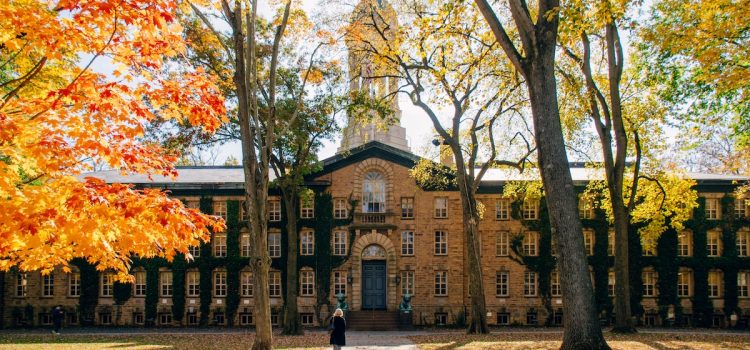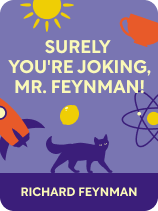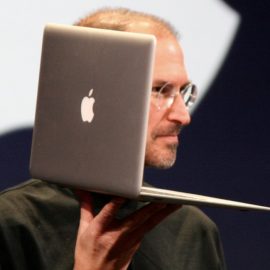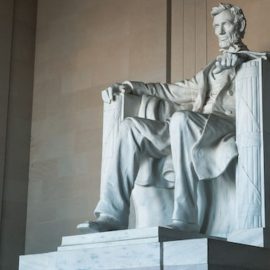

This article is an excerpt from the Shortform book guide to "Surely You're Joking, Mr. Feynman!" by Richard Feynman. Shortform has the world's best summaries and analyses of books you should be reading.
Like this article? Sign up for a free trial here.
How did Richard Feynman feel when Einstein attended one of his lectures? Why did an army general recruit Feynman when he was working on his doctorate?
In his memoir Surely You’re Joking, Mr. Feynman!, Richard Feynman recounts his years in school at MIT and Princeton, comparing and contrasting the two environments. He also explains how WWII shaped the start of his career.
Keep reading to learn about Richard Feynman’s education.
Richard Feynman’s Education
Richard Feynman’s education is expectedly impressive, with Feynman earning degrees from the Massachusetts Institute of Technology (MIT) and Princeton University. He attended MIT from 1935 to 1939 and was reluctant to leave after finishing his undergraduate work. However, MIT’s rules required its undergraduates to complete their advanced degrees elsewhere, so Feynman did his graduate studies at Princeton until earning his doctorate in 1942. Although he found Princeton to have a stuffier, more formal culture than MIT, Feynman describes its physics laboratory as a playground not unlike his cluttered workshop at home. Moving to Princeton was a blessing in that it pushed him to learn what the rest of the world was like, in terms of academics, people, and how physics was done.
(Shortform note: At the time when Feynman was attending college, both Princeton and MIT were renowned for their engineering programs and scientific research facilities, but the two universities had different focuses and priorities. In The Physicists, historian Daniel J. Kevles says that MIT’s mission was to provide students with the practical skills needed to fuel America’s growing industrialization, whereas Princeton also emphasized the humanities, social sciences, and arts in order to give its students the broad liberal arts education they’d need as future leaders. According to US News & World Report, Princeton and MIT are still among the top-ranked universities in the United States.)
While at Princeton, Feynman spent time with groups outside the physics department so he could learn what was going on in their fields. He says he was a nuisance at philosophy lectures because he had a habit of asking for definitions of fuzzy philosophical concepts. He enjoyed biology because there were so many interesting questions that scientists hadn’t been able to solve yet. He met scientists who could easily see mathematical problems in their heads, whereas Feynman had to grind away at them. He also gave a lecture that famous scientists such as Albert Einstein attended. This made him extremely nervous until the moment his presentation began and the science swept him away.
(Shortform note: A liberal arts environment such as Feynamn experienced at Princeton is designed to promote interdisciplinary learning so that students can make connections among various academic fields and develop a deeper understanding of the world. Liberal arts programs also help develop critical thinking and communication skills through the analysis and synthesis of different perspectives. However, a common criticism of liberal arts schools is that while giving students a broad range of knowledge, they sometimes fail to teach practical skills or prepare students for specific careers. As a result, those with liberal arts backgrounds may face difficulty finding employment in the workforce.)
Feynman’s First Job
As Feynman approached the end of his graduate studies, the US entered the Second World War. While he was still working on his Ph.D., a general came to Princeton looking for physicists to recruit, and Feynman volunteered, even though at the time very few people even understood what a physicist was.
After earning his doctorate, Feynman was recruited into the top-secret Manhattan Project team at Los Alamos, New Mexico, to develop the atomic bomb. Despite his Ph.D., Feynman recalls that he wasn’t knowledgeable about nuclear physics, and he felt he had a lot of catching up to do.

———End of Preview———
Like what you just read? Read the rest of the world's best book summary and analysis of Richard Feynman's "Surely You're Joking, Mr. Feynman!" at Shortform.
Here's what you'll find in our full Surely You're Joking, Mr. Feynman! summary:
- The memoir of award-winning scientist Richard Feynman
- A walk through Feynman's life, from college to winning the Nobel Prize
- Why enjoying life is just as valuable as your education






